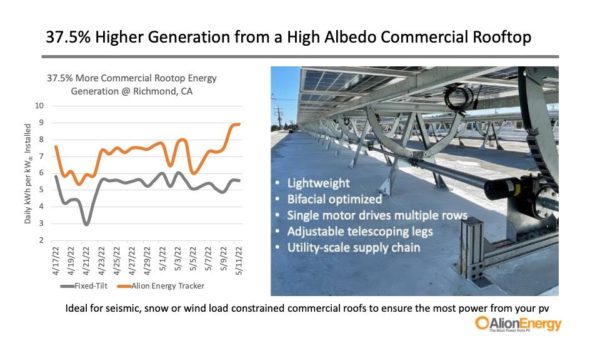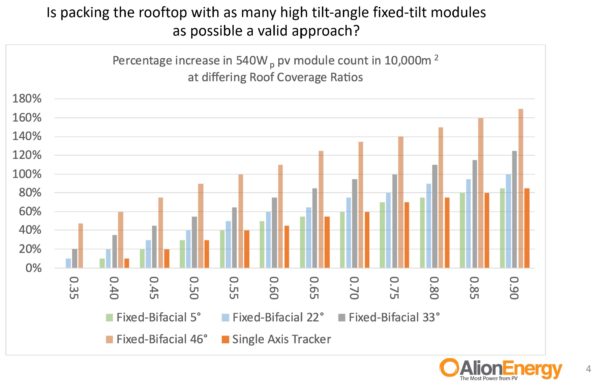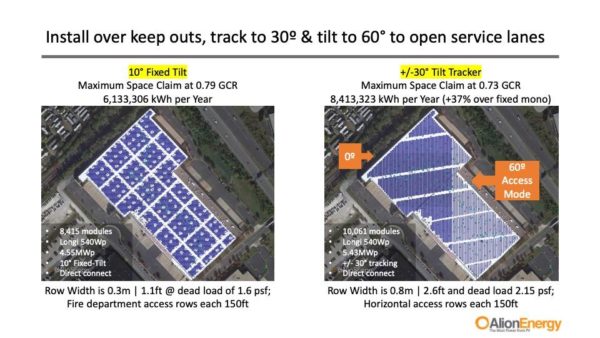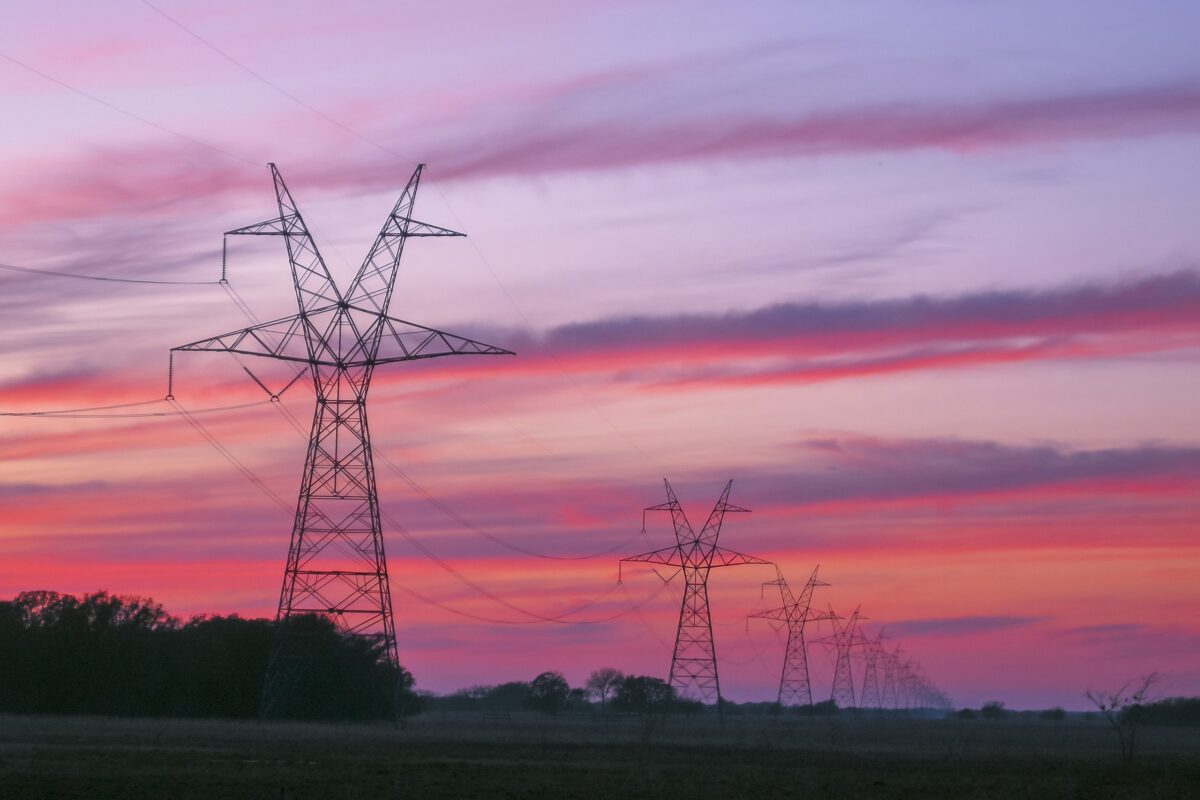Alion Energy’s single axis tracker racking product was originally designed to be deployed in regions where heavy installation equipment was more challenging to access, but labor might be more available. One aspect of this design philosophy is that the system is light and can be easily carried and assembled, and doesn’t require metal pilings to be driven deep into the ground.
Interestingly, this carries over to commercial rooftops.
Via a post on LinkedIn, Mark Kingsley, Alion CEO, shared that a commercial real estate group had installed a standard rooftop 10º fixed tilt mono-facial solar array, as well as a competing Alion system.

The results were as expected – 37.5% greater generation on a per watt basis from the single axis tracker, on a pristine white thermoplastic roof versus standard modules.
Of course, the real breakthrough is that they were able to get single axis trackers installed on a commercial rooftop at all!
There was no information shared about the total wattage that was able to be installed on the site, however, Alion did provide pv magazine USA with a technical powerpoint covering the deployment of their product on commercial rooftops (this data-driven document is available from Kingsley upon request).
Kingsley also commented on the aforementioned LinkedIn thread with the following image showing a hypothetical rooftop situation. This project is also reviewed in greater depth in the powerpoint presentation.

Looking closely, Alion is suggesting that they can actually fit *more* modules on the rooftop – and have a higher production rate from those modules due to common nuances of rooftop installation.
The rooftop in their example has a lot of skylights, and the overall structure is not facing due south. In this configuration, Alion suggests that they can fit 4.55 MW of modules on the Maryland structure with a standard 10º installation. This system is projected to generate 1.34 kWh per watt each year.
Alion has designed a system that is 5.4 MW – a full 18% increase in wattage due to systems ability to be installed directly over skylights without needing the standard setback! Additionally, this hardware is projected to generate 1.54 kWh per watt installed per year.
In this case, that works out to 37% more electricity from the same rooftop. And when the trackers are directly attached to the roof – a 2.15 pounds per square foot dead load.

Add in one Alion’s customized robotic cleaners, and the company says the levelized cost of electricity from the system falls to 4.67¢/kWh and generates 40% more electricity than a standard rooftop solar install.
And while this rooftop was selected to show off their hardware, it’s still an interesting best case scenario for us to consider.
This content is protected by copyright and may not be reused. If you want to cooperate with us and would like to reuse some of our content, please contact: editors@pv-magazine.com.







Potential concerns:
1. Are there now a bunch of holes in the roof compared to a ballast system?
2. Introducing moving parts to rooftop racking – what does this do to the racking warranty?
3. Some of these will almost certainly fail in the field due to moving parts – how easy are they to replace and what does that add to O&M costs?
What are your thoughts John?
1. Yes.
2. You have a different warranty and O&M costs to consder versus a fixed ballast system.
3. That answer I don’t know yet. Never actually dealt with the product.
I like the product idea, the exact same issues you brought up, are the ones I’d worry about. Specifically, O&M as it might be challenging to get a mechanical team out that knows this system well enbough versus just an electrician which is what most O&M is. That this is a newerproduct, means there will be less talent around to repair it, however, the sales pitch is the systems simplciity and how it can be worked with hands versus machines…but I am an optimist!
I’m confused, is it “37.5% greater generation on a per watt basis” or is it (with an added robot cleaner) “generates 40% more electricity than a standard rooftop solar install”? Because it is certainly unlikely to be both, given that these are different measurements. Sure, single axis will generate more on a “per watt basis” — but you will have a lot fewer watts available, given the additional spacing required with single axis due to shading issues. Indeed, given the low cost of solar modules, I’m hard-pressed to see how you can beat covering the whole roof with modules with no angle at all when looking at LCOE. I would really, really appreciate PV Magazine vetting confusing (or senseless) corporate press releases instead of simply reprinting them whole cloth.
It is both 40% and 37.5% because it seems they are different roofs. The 37.5% number is from a real installation in California on a per watt basis – I wans’t given data on total watts of the site. The 40% number comes from a simulation provided by Alion.
The article specifically references the two seperate systems.
Let’s try to clear up the confusion and start with an open mind. Here is the logic is greater detail:
1. This solution is about getting more energy from more expensive pv modules by adding bifacial gains and tracking. Modules are no longer 20 cents per watt and they are much bigger. This tracker allows one to (a) get the same energy from fewer pv modules and labor, or (b) by overcoming ‘keep out’ rules, to build over rooftops obstacles thereby add more modules to a rooftop. Please see the rooftop image John included in his article.
2. A rooftop tracker is not a panacea and a ‘horses for courses’ approach is recommended for each project. If you have other load factors limiting the number of pv modules you can place on a roof, this approach will gain in attractiveness. Examples include seismic loads and the reduced loads capacities on older buildings in the USA. It also addresses the very low load capacities on many buildings in tropical locations. This because CAPEX efficiencies were prioritized over load bearing in order to overcome higher construction and financing rates in these countries. The other use case is if you have a lot of skylights or low obstructions on the roof and you can reduce the pv module coverage lost to keep out areas thru the use of a more elevated tracker.
3. The majority of rooftop installs remain mono facial due to habit, wind loads, and the CAPEX cost increase required to build an “elevated fixed array” for bifacial. Hence the 37.5% gain is comparing a real world mono-facial array with a bifacial tracker. They are adjacent to each other on the same rooftop in California and the data is real. About 55% of the 37.5% gain comes from bifacial pv cells & better cooling over a 0.65 albedo roof, the balance of 45% of this 37.5% gain comes from adding tracking that is modified for rooftop space constraints.
4. The tracker must reduce its tracking range to accommodate 0.8m / 2.6′ panel edge-to-panel edge row widths when the panels are positioned at 0 degrees. This just under 3.1m or 10′ centerline to centerline, and is much narrower than the 6m / 19.7′ used by a tracker in an open field. Hence the tracking range reduces from +/- 60 degrees to +/- 30 degrees to reduce shading. However the tracker still provides ~ +15% energy gain vs. a fixed tilt (i.e., before adding in bifacial gains). Perhaps a simpler way to say this is a 1-x tracker losses less than 4% of it tracking gains when reducing tracking angle from 60 to 30 degrees. Backtracking helps here. So if you get a 19% gain from a field-based tracker in California, subtract 4% to get the 15% benefit on a roof with higher rows densities.
5. Operating and Maintenance. The bad news is you have a more complete and complex mechanism that will need to be remotely monitored. The main replacement will be batteries on the controllers every several years. Mechanicals are sound for the life of the project. The good news is trackers stay cleaner and reduce OPEX costs. In contrast, a 10 degree tilt fixed pv module tends to get quite dirty with baked on soiling. Whereas a tracker can still tilt to 60 degrees to ease row access and allow two rows to be cleaned more rapidly without robots. Also , the pv modules may be tilted during rain events so more soil is washed off. In snow, the bifacial pv module quickly melts the snow from the rear-side and the geared design of the tracker allow one to tilt it off and not deform the drive tube.
6. Alion Energy offers both ballasted and roof penetrating versions of this tracker. As our patented gears lock out each vertical upright, this tracker can stow at zero degrees and not flutter like traditional torque tube trackers. Due to this it requires less ballast in a wind event vs a fixed-tilt. Per ASCE7-16 code rooftop wind loads on a unenclosed 10 degree tilt structure are ~21% higher than at zero degrees. 10 degrees catches more uplift force than zero degrees. This number assumes 540Wp module dimensions and 100mph wind loads.
In summary, perhaps run you own analysis using +/-30 or +/-40 tracking angle with up to 0.73 GCR for direct connecting systems or 0.45 GCR for a ballasted system. This should keep loads below 12.2 kf/m^2 or 2.5PSF and be broadly in line with limits on fixed-tilt bifacial arrays. If you take the analysis all the way through to after-tax cash, you will see the true benefit of getting higher yields from your most expensive components – the pv modules.
What is surprising in Mark’s comment is that while the bifacial boost is over 20%, the single-axis gain is only 17%. Is that a function of the elevation of the table? Normally, I’d expect a single-axis to yield more like 25% over fixed tilt, where both use monos.
The bifacial boost is probably stronger than average due to the perrfectly new white roof underneath it